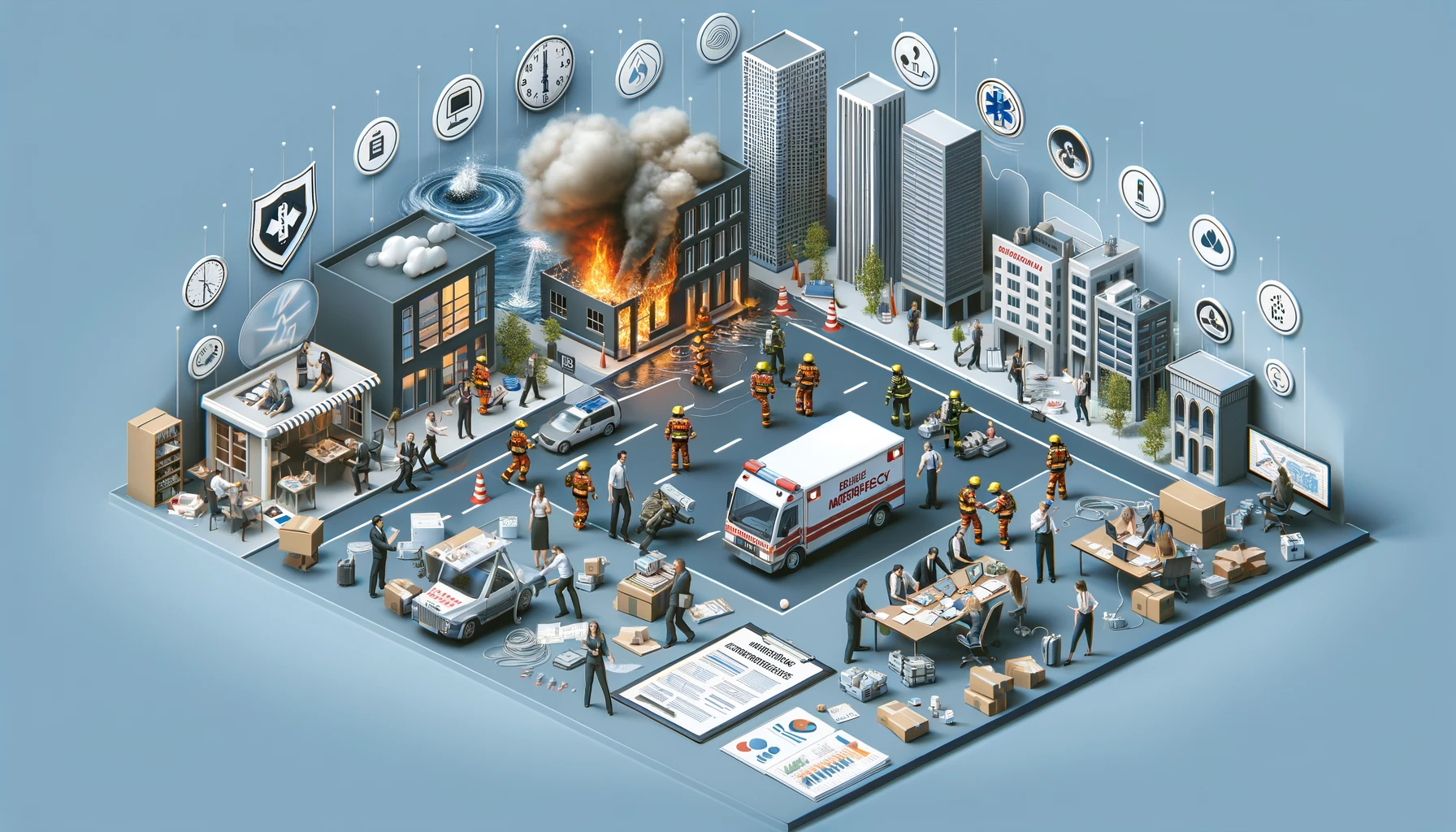Introduction to Business Continuity and Disaster Recovery: In the realm of organizational resilience, the adage “forewarned is forearmed” holds particularly true. Business continuity is not just a buzzword but a critical strategy that prepares companies to maintain essential functions during and after a disaster. The core aim of business continuity is to mitigate the impact of disruptions on the organization’s stakeholders, reputation, and bottom line. Understanding the importance of preparedness cannot be overstated; it’s about safeguarding the lifeblood of your business, ensuring that even in the face of unforeseen calamities, your operations can continue with minimal interruption.
Listen to a summary of this article here:
Download the Check list to track your process:
Checkbox – The Steps To Business Continuity and Disaster Recovery Planning
 |
 |
1.2. Overview of Business Continuity Planning (BCP) and Disaster Recovery Planning (DRP)
The business continuity planning process is a comprehensive approach involving the identification of critical operations, potential threats, and effective responses. At its heart, a Business Continuity Plan (BCP) is a blueprint that outlines how a company will continue operating during an unplanned disruption. It’s more than just a set of guidelines; it’s a roadmap to recovery, encompassing not only disaster response but also strategies to resume, recover, and restore operations to their pre-disaster state.
In tandem with BCP, Disaster Recovery Planning (DRP) focuses specifically on the recovery of technology systems and data after a crisis. In today’s digital age, data is often considered the crown jewel of a company, making DRP an indispensable component of the broader business continuity management framework.
1.3. Common Threats and Emergencies in the Workplace
Businesses today face a plethora of threats ranging from natural disasters like floods and earthquakes to human-induced crises such as cyber-attacks and technological failures. Each of these emergencies poses a unique challenge, yet they all share the potential to disrupt business operations significantly. Recognizing these threats and understanding their implications is the first step in crafting a robust business continuity strategy.
1.4. The Role of an Emergency Action Plan
An Emergency Action Plan (EAP) is the operative component of the BCP. It delineates the immediate actions to be taken in the wake of an incident. The EAP is not just a document but a dynamic tool that, when effectively implemented, can significantly reduce the severity of the disruption. It’s about having a clear, concise, and well-communicated plan detailing roles, responsibilities, procedures, and evacuation routes to ensure safety and rapid response.
In conclusion, the journey towards business resilience begins with a well-crafted Business Continuity and Disaster Recovery Plan. By understanding the importance of preparedness, comprehensively addressing the planning process, acknowledging the common threats, and establishing a functional Emergency Action Plan, businesses can position themselves to weather any storm. As the business environment continues to evolve, so too should your approach to business continuity, ensuring an agile, responsive, and resilient organization.
The Planning Process
2.1. Reviewing and Identifying Objectives
Initiating a robust business continuity planning process begins with a clear understanding of objectives. This critical step ensures alignment between the business continuity management framework and the company’s overarching goals. Objectives typically encompass safeguarding personnel, preserving reputation, minimizing financial loss, and ensuring the swift resumption of critical operations. Identifying these objectives early helps in setting a clear direction for the entire planning process.
2.2. Conducting a Risk Assessment
A thorough risk assessment forms the backbone of effective business continuity planning. This involves identifying potential threats to business operations, from natural disasters to cyber-attacks, and analyzing their likelihood and impact. The goal is to prioritize risks, allowing businesses to allocate resources more effectively and develop targeted strategies to mitigate these risks. This phase is critical to understand the specific vulnerabilities and threats your business faces and to prepare for them accordingly.
2.3. Classifying Response Resources
Once risks are identified and assessed, the next step is to classify response resources. This involves taking stock of all available resources, including personnel, equipment, technology, and information. Understanding what is at your disposal helps in effective planning and response. It’s also essential to identify any gaps in resources that need to be filled to ensure a seamless business continuity response.
2.4. Creating an Emergency Response Team
An emergency response team is a group of individuals tasked with executing the business continuity plan during a crisis. Selecting the right team members is crucial; they should have a clear understanding of the business continuity plan meaning and possess the skills and authority needed to make critical decisions. This team is responsible for carrying out the plan, coordinating efforts, and communicating with stakeholders during a disaster.
2.5. Assessing Applicable Regulations and Compliance
Compliance with legal and regulatory requirements is a non-negotiable aspect of business continuity planning. Businesses must understand and adhere to all relevant laws, regulations, and standards that apply to their industry and operations. This includes data protection laws, industry-specific safety regulations, and any other legal requirements that could impact the business continuity management framework. Failure to comply can lead to legal repercussions and undermine the effectiveness of the business continuity plan.
In conclusion, the planning process is a comprehensive and critical phase in business continuity and disaster recovery. It sets the foundation for a resilient organization capable of withstanding and recovering from disruptions. By thoroughly understanding and executing each step of this process, businesses can ensure they are well-prepared for any eventuality, safeguarding their operations, reputation, and stakeholders against a wide array of risks.
Development of Response Strategies
3.1. Establishing a Protective Action Response Strategy
In the fabric of a robust business continuity management framework, establishing a protective action response strategy is pivotal. This proactive approach focuses on safeguarding personnel and assets during a crisis. Strategies may include evacuation, shelter-in-place, lockdown, or other procedures depending on the nature of the threat. The key is to tailor these strategies to the specific needs and layout of your organization, ensuring a swift and safe response to any incident.
3.2. Developing a Hazard-Specific Response Strategy
A one-size-fits-all approach does not apply when dealing with diverse threats. Each hazard demands a unique response. Whether it’s a natural disaster, technological failure, or security breach, developing a hazard-specific response strategy is essential. This involves analyzing each potential threat identified during the risk assessment phase and crafting detailed response plans. These plans should outline the steps to mitigate damage, maintain or quickly resume critical operations, and ensure the safety of all personnel.
3.3. Coordination with External Emergency Services
No business is an island, especially when it comes to disaster response. Coordination with external emergency services is a cornerstone of an effective business continuity plan. Establishing relationships with local fire departments, law enforcement, medical responders, and other agencies ensures that your organization can effectively collaborate and communicate during a crisis. Understanding their capabilities and response times helps in creating a more realistic and effective business continuity planning process.
3.4. Integrating Communication Plans
Clear and effective communication is the lifeline of any emergency response. Integrating communication plans within your business continuity strategy is non-negotiable. This involves not only the means of communication but also the protocols for who should communicate what, to whom, and when. Ensure that your plan includes backup communication methods in case standard systems fail. Regular training and drills are essential to ensure that all team members understand their roles and the communication protocols.
In conclusion, developing response strategies is a critical phase in the business continuity planning process. It’s about being proactive, detailed, and practical. By establishing protective action response strategies, developing hazard-specific plans, coordinating with external services, and integrating communication protocols, your organization can stand resilient in the face of any disaster. This not only safeguards your operations and assets but also reinforces your commitment to the safety and well-being of your employees and stakeholders.
Implementation and Training
4.1. The Significance of Employee Involvement and Training
A robust business continuity plan is only as effective as the people who implement it. Employee involvement and training are paramount to ensure that when a crisis strikes, everyone knows their role and how to execute the plan effectively. Training programs should be comprehensive, covering all aspects of the business continuity plan meaning and its application. Regular training sessions keep the team’s skills sharp and ensure new members are brought up to speed. Involving employees in drills and discussions about the plan fosters a culture of preparedness and resilience.
4.2. Conducting Drills and Exercises
Drills and exercises are critical components of the business continuity planning process. They provide a practical, hands-on experience that tests the effectiveness of the plan and the readiness of the team. These simulations should mimic potential scenarios as closely as possible and involve every part of the organization. After each drill, gather feedback and conduct a debriefing session to identify areas for improvement. Continual refinement through these exercises ensures that the plan evolves and adapts to new threats and changes in the organization.
4.3. Deployment of Response Tactics and Strategies
The actual deployment of response tactics and strategies is where the business continuity plan is put to the test. This phase involves mobilizing the emergency response team, executing the communication plan, and implementing the specific steps outlined for various scenarios. It’s crucial that the deployment is swift, coordinated, and in line with the established protocols. The success of this phase heavily relies on the groundwork laid during the planning and training stages.
4.4. Continual Review and Improvement of the Plan
The business continuity management framework is not static; it requires ongoing evaluation and improvement. After every drill, incident, or significant change in the organization or its environment, review the plan. Look for lessons learned, and make necessary adjustments. This iterative process ensures that the plan remains relevant, comprehensive, and effective. Embrace a culture of continuous improvement, where feedback is encouraged, and the plan is seen as a living document that evolves with the organization.
In conclusion, the implementation and training phase is critical to the success of a business continuity strategy. It’s about bringing the plan off the page and into action. Through rigorous training, regular drills, effective deployment, and continuous improvement, organizations can ensure that they are ready to face disruptions head-on. Remember, a plan is only as good as its execution, and an untrained team can’t execute a plan effectively. Invest in your people and processes to build a resilient, responsive, and robust organization.
Technology and Data Recovery
5.1. Understanding Technology’s Role in Disaster Recovery
In an era where digital assets form the core of many businesses, understanding technology’s role in disaster recovery is not just beneficial—it’s imperative. The business continuity plan meaning today extends far beyond physical assets, focusing significantly on data and technology systems. These systems are often the lifelines that keep operations running smoothly, and their recovery is crucial in the event of a disruption. A resilient business continuity management framework must, therefore, include strategies for technology recovery, ensuring minimal downtime and data loss.
5.2. Data Backup and Recovery Solutions
Data backup and recovery solutions are the safety nets of your business continuity planning process. Regular backups to secure, offsite locations ensure that your data can be recovered quickly and efficiently, minimizing the impact on business operations. Consider diversifying your backup methods between physical and cloud storage to enhance security and accessibility. Equally important is regularly testing these backups to confirm that data can be restored correctly and within an acceptable recovery time.
5.3. Maintaining Operations During a Disaster
The primary goal of any business continuity plan is to maintain operations during a disaster. This involves having redundant systems in place, such as backup power supplies, alternate work locations, and secondary communication systems. These redundancies ensure that critical business functions can continue even when the primary systems are compromised. Planning for operational continuity involves analyzing each department’s critical functions and determining the necessary resources to maintain these functions during a crisis.
5.4. Post-Disaster Data Restoration
Once the immediate crisis has passed, the focus shifts to post-disaster data restoration. This phase is about transitioning from a temporary emergency mode back to normal operations. It involves not only restoring data and systems but also ensuring they are fully functional and secure. This process should be carefully planned and executed to avoid further disruptions and ensure data integrity. It’s also an opportune time to analyze the event, assess the response’s effectiveness, and update the business continuity plan accordingly.
In conclusion, technology and data recovery are pivotal elements of a robust business continuity strategy. In today’s interconnected world, a business’s resilience is heavily reliant on its ability to protect and recover its digital assets. By understanding technology’s role, implementing effective backup and recovery solutions, maintaining operations during a disaster, and efficiently restoring data post-disaster, businesses can ensure they are well-equipped to handle disruptions and maintain continuity in an ever-evolving digital landscape.
Case Studies and Real-World Applications
6.1. Learning from Past Disasters
History is the best teacher, and this is particularly true when it comes to business continuity. Analyzing case studies of past disasters and how various organizations responded provides invaluable insights. These real-world scenarios demonstrate the practical application of the business continuity planning process and highlight both successes and areas for improvement. Understanding how similar businesses coped with and recovered from disruptions can guide and refine your own strategies.
6.2. Success Stories of Effective BCP and DRP
Success stories serve as a testament to the effectiveness of well-crafted business continuity and disaster recovery plans. Examining these instances not only serves to validate the business continuity plan meaning but also provides a framework for what works in real-life situations. These narratives often reveal innovative strategies and proactive measures that ensured business continuity against all odds. They also underscore the importance of a comprehensive business continuity management framework that can adapt and respond to any crisis.
6.3. Common Pitfalls and How to Avoid Them
Equally important as the success stories are the lessons learned from less successful attempts at business continuity. Common pitfalls, such as inadequate risk assessment, poor communication, lack of employee training, or failure to regularly update the plan, can lead to disastrous consequences. By understanding where others have gone wrong, your organization can proactively address these areas in your own business continuity planning process, turning potential weaknesses into strengths.
In conclusion, real-world case studies are a vital component in understanding and developing a robust business continuity and disaster recovery plan. They provide concrete examples of the principles and practices discussed in the theoretical framework and offer a clear picture of what works and what doesn’t. By learning from the past, celebrating successes, and understanding failures, organizations can equip themselves with the knowledge and insight needed to navigate the complexities of business continuity and emerge stronger from any disaster.
Future-Proofing Your Business
7.1. Emerging Threats and How to Prepare
In an ever-evolving landscape, businesses must stay vigilant and forward-thinking. Understanding and preparing for emerging threats is a crucial aspect of a dynamic business continuity management framework. As technology advances and global interconnectivity increases, so do the complexities of potential disruptions. This section explores the latest trends in threats, from cyber-attacks to climate change, and how businesses can adapt their strategies to stay ahead.
7.2. Innovations in Disaster Recovery and Business Continuity
As the risk landscape changes, so too do the solutions. Innovations in disaster recovery and business continuity are continually reshaping how businesses plan for and respond to disruptions. This part of the chapter delves into the latest technological advancements, methodologies, and tools that are setting new standards in resilience planning. From cloud-based recovery solutions to AI-driven risk assessment tools, understanding these innovations can significantly enhance your business continuity planning process.
7.3. Building a Resilient Organizational Culture
The backbone of any successful business continuity plan is the people who implement it. Building a resilient organizational culture is about more than just having the right plans and tools in place; it’s about creating an environment where preparedness and adaptability are part of the DNA. This section discusses strategies for fostering a culture of resilience, including regular training, open communication, and leadership involvement. It also explores how to embed business continuity into every aspect of your organization, ensuring that every employee understands the business continuity plan meaning and their role within it.
In conclusion, future-proofing your business is an ongoing process that requires vigilance, innovation, and a culture of resilience. By staying informed about emerging threats, embracing new technologies, and cultivating a strong organizational culture, businesses can not only survive but thrive in the face of adversity. This proactive approach to business continuity ensures that your organization is always prepared for whatever the future may hold, maintaining operational integrity and safeguarding your most valuable assets.
FAQs
8.1. What are the first steps in creating a BCP and DRP?
The journey to robust business continuity begins with understanding your organization’s unique needs and risks. The first steps include conducting a thorough risk assessment, identifying critical business functions, and determining the resources necessary to maintain those functions during a crisis. It’s also crucial to involve key stakeholders from the outset, ensuring that the business continuity plan meaning and objectives align with the overall organizational goals.
8.2. How often should we test and update our emergency plans?
Regular testing and updating of your emergency plans are vital to their effectiveness. Best practices suggest reviewing and testing your business continuity and disaster recovery plans at least annually or whenever significant changes occur within your organization or the external environment. This ensures that your strategies are always up-to-date and that your team is prepared to act on them.
8.3. What are the critical components of an effective emergency response team?
An effective emergency response team is comprised of individuals with clearly defined roles and responsibilities, who have the authority to make crucial decisions during a crisis. The team should include representatives from all critical areas of your business, and members should have a deep understanding of the business continuity management framework. Regular training and team-building exercises can enhance their effectiveness and cohesion.
8.4. How can small businesses implement effective BCP and DRP on a limited budget?
Small businesses can still develop effective business continuity and disaster recovery plans even on a limited budget. The key is to focus on the most critical business functions and the simplest, most cost-effective solutions to maintain them during a crisis. Utilizing cloud-based technologies for data backup, encouraging a culture of resilience among staff, and leveraging community resources are all cost-effective strategies that can significantly enhance a small business’s resilience.
In conclusion, these FAQs address some of the most common concerns and questions surrounding business continuity and disaster recovery planning. They underscore the importance of a well-thought-out business continuity management framework and the need for regular review and practice of your business continuity planning process. By staying informed and proactive, businesses of all sizes can enhance their resilience and readiness for whatever challenges the future may hold.
Recap of Key Strategies for Business Continuity and Disaster Recovery
As we conclude this comprehensive guide, it’s essential to recap the key strategies that underpin effective business continuity and disaster recovery. First and foremost, understanding the importance of preparedness cannot be overstated. It is the foundation upon which resilient organizations are built. The business continuity planning process, with its emphasis on risk assessment, resource classification, and response strategy development, provides a structured approach to crisis management. Implementation and regular training ensure that plans are not merely theoretical but actionable and ingrained in the organizational culture. Finally, technological adaptability and learning from both successes and failures are what keep a business continuity plan dynamic and effective.
9.2. The Importance of Proactive Planning
Proactive planning is at the heart of business continuity and disaster recovery. It’s about foreseeing potential crises and having a plan in place before they occur. This anticipatory approach is what separates resilient businesses from those caught off guard by unexpected events. The business continuity management framework is not just a set of documents but a mindset that permeates every level of the organization. It’s about building an organizational culture that values vigilance, preparedness, and the ability to adapt to change.
9.3. Encouraging Continuous Learning and Improvement
The landscape of risks and threats is constantly evolving, and so too should your approach to business continuity and disaster recovery. Continuous learning and improvement are vital to ensuring that your strategies remain relevant and effective. This means regularly reviewing and updating your plans, staying informed about new threats and solutions, and fostering an environment where feedback and innovation are encouraged. It’s a cycle of assessment, implementation, review, and refinement.
In conclusion, the journey towards robust business continuity and disaster recovery is ongoing. It requires commitment, foresight, and a willingness to continually adapt and improve. The business continuity plan meaning goes beyond mere survival; it’s about thriving in the face of challenges, safeguarding your stakeholders, and securing your business’s future. By embracing the principles and strategies discussed in this guide, you can build a resilient organization ready to face whatever the future may hold.









